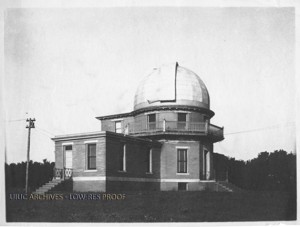[Entry 2 of 3 on the observatory at UIUC; read Entry 1 here.]
The University of Illinois Observatory held an impromptu open house last weekend, so we dragged a friend to campus so she could experience some sky-watching. She seemed genuinely thrilled by both the view of Saturn through the 12″ refractor and the view of the moon through a light bucket (1o” Dobsonian reflector) the UIAS had set up on the lawn to the west of the observatory. UIAS is a friendly group, and I highly recommend joining their listserv if you live in the area so you receive announcements about their open houses.
I’ve already written quite a bit about the building, but I was struck anew by the architecture while walking around the first floor. More specifically, I was struck by the pendentives, those transitional elements that let builders set a round dome on a square (or in this case, octagonal) building. In European building traditions, pendentives are usually covered with plaster so the surface is smooth. The pendentives in the observatory at UIUC are a little more utilitarian, however:
The pendentives here are exposed brick, painted but not disguised with plaster. (As an aside, the photo above also shows an antique 6″ equatorial refractor.) Before going upstairs, I thought to myself, “This is a very honest building.” The repressed brick out of which the walls and telescope were built is readily apparent. The warm temperature inside also was fairly honest. During the cooler evening hours, the masonry off-puts the heat it stored during the day, which would be a good thing if you were trying to heat the place, but is actually a bad thing because the radiation causes turbulence just when you want to start using the telescope.
At any rate, from the inside, the observatory seems like an honest building. It’s not quite as honest from the outside, however. Well, the observatory’s octagonal shape remains quite obvious, even though the east side of the building has been covered up by later additions:
Most of the exterior materials are constructionally transparent. The walls are made of brick, the pilasters are made of brick, the door and window headers are made of limestone. The balcony railing is painted wood, the dome roof adequately expresses the shape of the interior of the dome. On the other hand, the brackets under the lip of the dome are completely decorative, having no real role in the support of the roof structure. Moreover, they’re not even wood, but sheet metal, crimped and folded into the curves.
If you look closely at the brackets on the far left and right (click on the photo to enlarge), you can see they’re starting to pull apart. So, this is an interesting, but dishonest building, if you buy into the Modernist myth of materials necessarily expressing their function (which I only do on every other Friday). It’s quite different from it’s Big Ten counterpart, Kirkwood Observatory at Indiana University, despite the fact both observatories house 12″ refracting telescopes. One of the IUAS hosts offered to give me a tour of the building during daylight hours, so expect an entry discussing the instruments closer to the beginning of fall semester.










